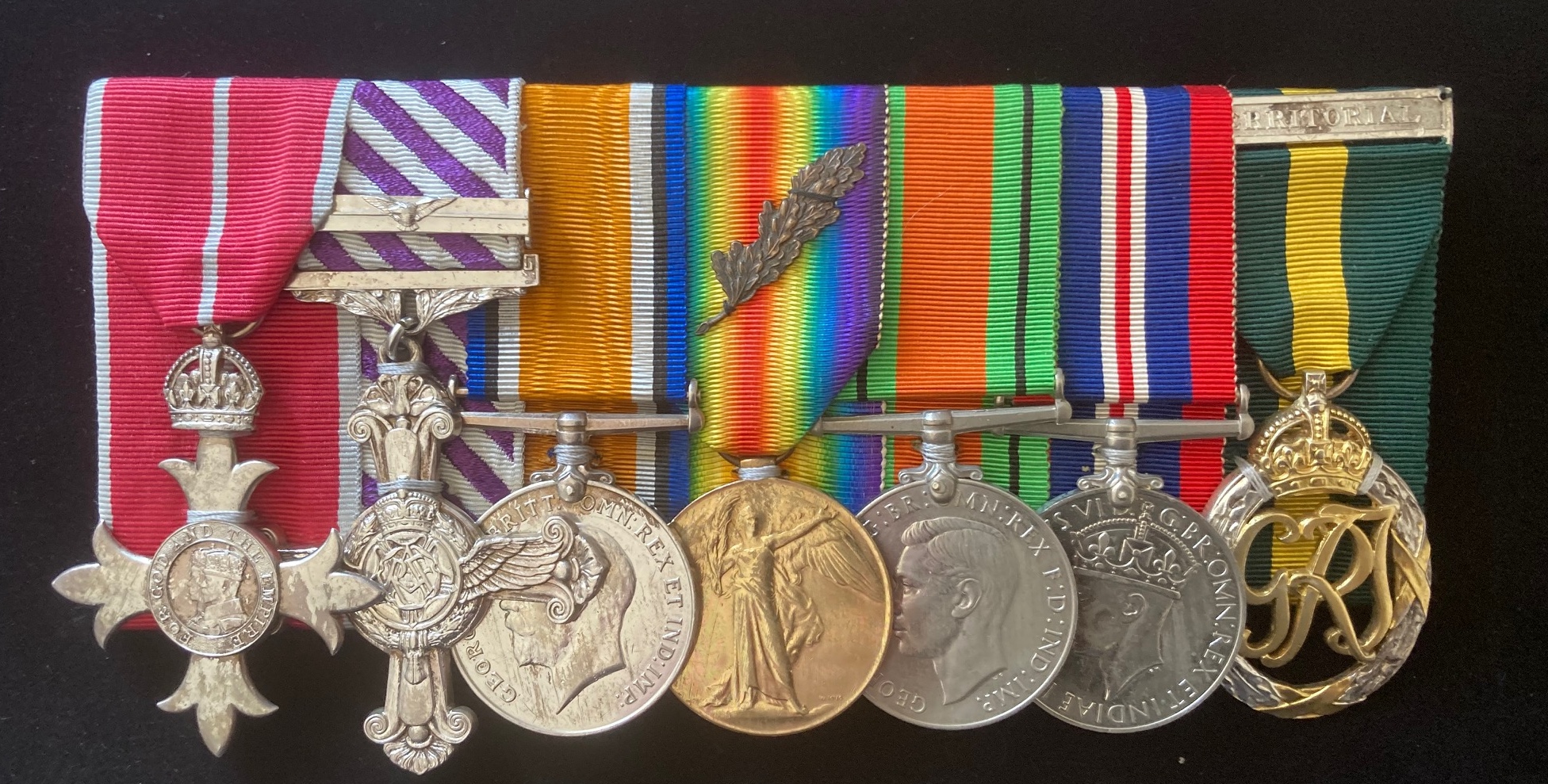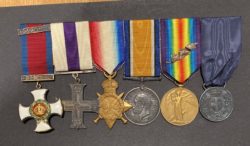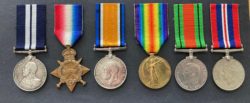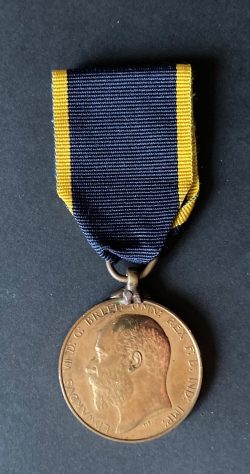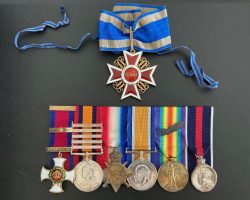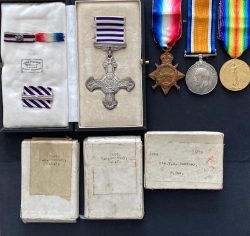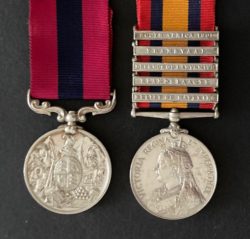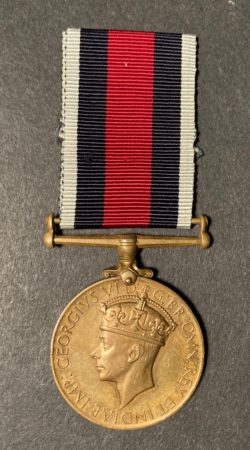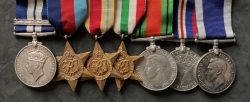Great War Bristol Fighter Pilot 26 Victory Ace’s Distinguished Flying Cross and Second Award Bar to Major W.F.J. “Jim” Harvey, M.B.E., D.F.C., T.D., Royal Air Force, late Royal Flying Corps, accredited with 26 victories, of which 18 were with his front gun, whilst flying with No.22 Squadron, all Victories occurring between March and August 1918,
£16,000.00
1 in stock
M.B.E. 2nd type, Military Division; Distinguished Flying Cross, (GV), with Second Award Bar, British War Medal Medal, Victory Medal , Mentioned in Despatches Oakleaf, (Capt. W, R.A.F.), Defence Medal, War Medal, Territorial Efficiency Decoration, (GVI.) reverse dated 1945, with Territorial top bar.
Mounted as worn.
M.B.E. London Gazette for 10 April 1945. Captain (temporary Major) William Frederick James Harvey, D.F.C. (73684), Royal Artillery, Territorial Army.
Distinguished Flying Cross
London Gazette 2 July 1918. Lt. William Frederick James Harvey.
As a fighting pilot this officer has the real offensive spirit regardless of personal danger. He has destroyed several enemy machines whilst fighting against superior numbers.
Original recommendation expands
‘For conspicuous gallantry and devotion to duty. He has shown himself to possess the real offensive spirit and his qualities as a fighting pilot, combined with a total disregard of personal danger, has set a fine example to other pilots in the squadron. He has personally destroyed enemy aircraft as under: – on 25 May 1918 when leading a formation of three, 9 or 10 small type two-seater enemy aircraft were seen below in the vicinity of La Bassee. He dived and attacked one which went down out of control and was seen to crash. Confirmed by other members of the patrol. On 26 May 1918 when on offensive patrol a general engagement ensued with 20 Pfalz South East of Armentieres. One of the enemy aircraft was shot down completely out of control but was not seen to crash owing to the nature of the fight. On the 22 May 1918 when on offensive patrol he fired a good burst into a DFW between Merville and Estaires. The enemy aircraft went down wing over wing, side-slipping and absolutely out of control, and was watched until out of sight in the mist below. In addition to the above, this officer has destroyed three other enemy aircraft; one in flames, one crashed, and one out of control.’
Bar to the Distinguished Flying Cross London Gazette 3 December 1918. Lieut. (A./Capt.) William Frederick James Harvey, D.F.C. (France)
A brilliant fighting pilot, who has proved himself a capable leader in many offensive patrols. During the August operations he personally accounted for seven enemy machines and, in company with another
pilot, destroyed an eighth, displaying courage and tenacity of high order.
(D.F.C. gazetted 2nd July, 1918.)
Original recommendation for his award expands
‘For conspicuous gallantry and devotion to duty. He has led numerous offensive patrols and has proved himself to be an efficient and capable Flight Commander. By his skill, tenacity and dash he has shown himself to be a brilliant fighting pilot. Since the award of the Distinguished Flying Cross, he had personally accounted for enemy aircraft as follows: – on the 22 August 1918 when on offensive patrol North East of Bailleul a Halberstadt two-seater was seen flying West. He attacked and fired 150 rounds. The enemy aircraft rolled over and fell completely out of control emitting smoke and was watched down until almost invisible, clouds of black smoke and flame then appeared, presumably on crashing and enemy aircraft was undoubtedly destroyed. On the 21 August 1918 when on offensive patrol in the vicinity of Ervillers he shot down out of control one of four armoured two seater’s that were attacking our troops. On the 16 August 1918 when on offensive patrol South East of Lille he observed two formations of enemy aircraft 3,000 feet below. He dived on a Pfalz and fired long bursts at close range. Enemy aircraft fell out of control and was seen to crash by another pilot between Tretin and Lequin. On the 14 August 1918 when on patrol South East of Lille he shot down a Pfalz completely out of control. Confirmed by Observer and another pilot. On the 13 August 1918 when leading an escort to a bomb raid 20 to 30 enemy aircraft were coming up to intercept the bombers in the vicinity of Cambrai. He dived on a Rumpler two-seater and fired bursts until within short range. Enemy aircraft fell completely out of control and was seen to crash by another pilot two miles North North-West of Cambrai. On the 8 August 1918 when on escort 9 or 10 enemy single seaters attacked the formation North East of Vitry. He fired a long burst into a Pfalz which fell out of control and was seen to crash near the railway North East of Vitry. With another pilot he then dived on another enemy aircraft. On zooming and turning he saw the enemy aircraft at 6,000 feet in flames.’
Harvey had become the Royal Air Force’s first recipient of the Distinguished Flying Cross with Second Award Bar.
Mentioned in Despatches London Gazette 31 December 1918. Harvey, Lt. (A./Capt.) W. F. J., D.F.C., 22nd Sqdn., in ‘Sir D. Haig’s Despatch of the 8 November, 1918, submitting names deserving of special mention.
Territorial Efficiency Decoration in the London Gazette 13 December 1945. Capt. (T/Maj.) W. F. J. Harvey (73684) Royal Artillery.
William Frederick James Harvey, known as ‘Jim’, was born on 8 January 1897 in Hackney, London, attended Brighton, Hove & Sussex Grammar School, and on the outbreak of the Great War, saw home service from 3 Aug. 1914 as a Dispatch Rider in a Signalling Company of the Royal Engineers, Territorial Force, (Home Service) until the end of 1916 before being commissioned, and transferring as a 2.Lieutenant into the Royal Flying Corps 5 Jan. 1917.
Having undergone pilot training, he then joined No.22 Squadron out on the Western Front as a fighter pilot flying in Bristol F.2B fighters from Jan. 1918, and by August 1918, Harvey together with his Observers, would have accounted for a remarkable eighteen aircraft shot down with his front gun, and a further eight with his rear gun, he having been personally involved in the destruction of no less than 26 enemy aircraft.
Combat Victories all on Bristol Fighter of 22 Squadron.
16.3.1918 Pfalz DIII, Out of Control, Beaumont.
18.3.1918 Albatros DV, Destroyed (Flames), Carvin.
24.3.1918 Albatros DV, Destroyed, S.E. Arras.
24.3.1918 Albatros DV, Out of Control, S.E. Arras.
25.3.1918 Albatros D.V. Destroyed, St. Ledger.
30.3.1918 Balloon, Destroyed, N.E. Albert.
20.5.1918 Balloon, Destroyed, Bailleul.
20.5.1918 Balloon, Destroyed, Bailleul.
22.5.1918 D.F.W. C, Out of Control, Merville-Estaires.
26.5.1918 Pfalz DIII, Out of Control, Armentieres-Lille.
28.5.1918 C Type, Destroyed, La Bassee.
28.5.1918 C Type, Destroyed, La Bassee.
10.7.1918 Fokker DRI, Destroyed, S.E. Lille.
10.7.1918 Fokker DRI, Destroyed, S.E. Lille.
20.7.1918 Fokker DVII, Destroyed, S. Lille.
20.7.1918 Fokker DVII, Destroyed, S. Lille.
20.7.1918 Fokker DVII, Out of Control, S. Lille.
8.8.1918 Pfalz DIII, Destroyed, N.E. Vitry.
8.8.1918 Pfalz DIII, Destroyed, N.E. Vitry.
11.8.1918 Fokker DVII, Out of Control, S.E. Armentieres.
13.8.1918 Rumpler C, Destroyed, N.W. Cambrai.
13.8.1918 Pfalz DIII, Out of Control, N.W. Cambrai.
14.8.1918 C Type, Out of Control, S.W. Lille.
16.8.1918 Pfalz DIII, Destroyed, S.S.E. Lille.
21.8.1918 C Type, Out of Control, Ervillers.
22.8.1918 Halberstadt C, Destroyed, N.E. Bailleul.
16.3.1918 Pfalz DIII, Out of Control, Beaumont.
This was Harvey’s first victory when flying at a height of 13,000 feet, in the locality of OIGNES and BEAUMONT, with Sergeant A. Burton as his Observer, and having just come out of an engagement with 7 Albatros scouts. Harvey’s combat report reads: ‘At 10.45 am I observed a formation of 6 Pfalz scouts near OIGNES, 1,500 feet below us. I dived on one and fired a long burst. My Observer continued firing and the enemy aircraft turned over and went down completely out of control spinning irregularly and falling sideways until out of sight. This machine was observed to be completely out of control by Lieutenant Wells.’
18.3.1918 Albatros DV, Destroyed (Flames), Carvin.
Harvey’s second victory came two days later ‘While on patrol I saw 3 Albatros scouts near CARVIN at 13,000 feet, and 2,000 feet below us. The formation dived and I fired a long burst at the enemy aircraft nearest me. I observed the enemy aircraft quiver and dive and it fell in flames. This machine was observed to fall in flames by S.E.5’s of 40 Squadron.’
24.3.1918 Albatros DV, Destroyed, S.E. Arras and Albatros DV, Out of Control, S.E. Arras.
On 24 March he scored his third and fourth victories, both Albatros D.V’s to the South East of Arras, when on an offensive patrol at 12,000 feet with Lieutenant H.F. Moore as his Observer. ‘While on patrol a formation of 8 or 9 enemy aircraft was seen 3000 feet below us. The formation dived and I got a good burst at 1,000 foot range into one of the enemy aircraft. The enemy aircraft side-split steeply and I saw a thin stream of smoke coming from the left of the fuselage. The machine was seen to crash by Captain R.S.P. Boby.’ His Observer then recorded: ‘While on offensive patrol the formation dived on nine enemy aircraft which were 3,000 feet below us. When my pilot pulled out of the dive, I fired on one and I saw the machine which I fired at dive vertically, turn on its back and fall sideways completely out of control. The formation then swerved quickly and I lost sight of it.’
25.3.1918 Albatros D.V. Destroyed, St. Ledger.
The next day, he claimed his fifth victory, and reached ace status, when he shot down an Albatros D.V. at 9,000 feet over St Leger, flying with Lieutenant H.P. Moore again as his Observer. ‘While on patrol we met six or seven enemy aircraft 1,500 feet below us. The formation dived and I put a long burst up to a close range into a blue Albatros Scout. The left wing folded back. This enemy aircraft was seen going down by 2.Lieutenant Davison and seen to crash by Sergeant Bedding, both of No.22 Squadron.’
30.3.1918 Balloon,
Destroyed, N.E. Albert.
On 30 March, he claimed his sixth victory, this time a German observation balloon, when on an offensive patrol at 4,000 feet to the North East of ALBERT, with Moore once again as his Observer. ‘While on patrol my Observer fired a long burst at a hostile balloon. A cloud obscured the balloon for a short time and when it had passed a large ball of smoke was seen and no balloon. I fired at another balloon South East of Albert which was drawn down very fast.’ His Observer wrote: ‘Fired 200 rounds at roads on Eastern approaches to ALBERT. Fired 150 rounds at an enemy observation balloon at fairly close range. A cloud of mist passed between it and us and when mist cleared there was no balloon but a large cloud of black smoke.’
During April 1918, Harvey transferred into the Royal Air Force on its formation, but otherwise the month was quiet with no victories. However late May saw considerable action.
20.5.1918 Balloon, Destroyed, Bailleul and another Balloon, Destroyed, Bailleul.
On 20 May he destroyed two observation balloons in a single sortie over BAILLEUL whilst flying an offensive patrol between ARMENTIERES and ESTAIRES at heights ranging from 12,000 to 5,000 feet, with Lieutenant G. Thomson as his Observer. ‘I was dived on when at 11,000 feet by a wedged shaped formation of 10 machines which appeared to be a cross between a Bristol Fighter and a Dolphin. These machines appeared to have back stagger and a fairly short fat body. I easily out dived them.’ Then ‘With two other machines of this Squadron, I dived on several hostile kite balloons. One of these I saw go down in flames and another was seen to go down by members of our escort but I cannot definitely confirm it was mine. My Observer fired at one which had been drawn down and when last seen it was burning on the ground. At 5.30 pm every hostile balloon between BAILLIEUL and LA BASSEE had been driven down. I fired 600 rounds of Buckingham and ordinary ammunition and my Observer 300.’ His Observer reported: ‘My pilot dived on a hostile balloon, locality, near BAILLEUL. The enemy balloon burst into flames after a short burst from the pilot’s gun. On turning East from this balloon I observed another balloon on my right being hauled down. I fired a good burst at it near the ground and it immediately burst into flames. Buckingham ammunition was used.’
22.5.1918 D.F.W. C, Out of Control, Merville-Estaires.
Then on 22 May he claimed his ninth victory, a two seater D.F.W ‘C’ aircraft that was camouflaged blue, when flying on an offensive patrol at between 14,000 and 10,000 feet, between MERVILLE and ESTAIRES, with Thomson again flying as his Observer. ‘While on patrol we saw three S.E.5’s being followed very closely from behind by an enemy aircraft two seater. The formation dived on this enemy aircraft which had turned East on our approach. The S.E.5’s continued West and disappeared. The whole formation in turn dived on this enemy aircraft. I pulled out and dived again getting a good burst in at moderate range. The enemy aircraft then turned over and went down wing over wing, side slipping and absolutely out of control. Enemy aircraft was watched until out of sight in the mist, by 2.Lieutenant C.G. Gass of the formation. I have continually noticed on first crossing the lines that a number of bursts of black A.A. fire corresponding to the number of machines in the formation is put up at us. This has very often been followed by three bursts of white A.A fire.’
26.5.1918 Pfalz DIII, Out of Control, Armentieres-Lille.
On 26 May he claimed his tenth kill, this time a Pfalz D.III when flying on an offensive patrol between ARMENTIERES and LILLE at 16,000 feet, with Thomson again flying as Observer. His Observer recorded ‘Whilst flying South East of ARMENTIERES to LILLE we encountered about 20 enemy aircraft. A general engagement ensued and my pilot dived on one enemy aircraft. He pulled out of the dive allowing me to get a complete drum into a Pfalz Scout at 100 yards. All my shots went into the pilot’s cockpit and the machine turned completely over a few times and then went into a spinning nose-dive, but owing to the nature of the flight I did not have time to watch it crash but I am certain I must have killed the pilot, and that the machine went down completely out of control.’
28.5.1918 C Type, Destroyed, La Bassee and another C Type, Destroyed, La Bassee.
Then on 28 May, Harvey and his Observer claimed two victories of enemy two seater’s within five minutes when flying on an offensive patrol at 15,000 feet over LA BASSEE, with Thomson again flying as his Observer. Harvey recorded: ‘While leading a formation of three machines I saw nine or ten enemy aircraft going South East and 1,000 feet below me. I got into a favourable position and dived on one which went down out of control and was seen to crash by other members of the patrol and myself at about S.14. I then continued zooming and diving and later my Observer fired a drum at very close range into another enemy aircraft which also crashed at the same pinpoint. I also saw two other enemy aircraft going down absolutely out of control.’ His Observer recorded: ‘Whilst flying along the line towards MERVILLE from LA BASSEE we encountered and engaged about 10 enemy aircraft. My pilot dived on one and I saw this enemy aircraft go down out of control and crash in S.14. I then fired two drums into another enemy aircraft which went down out of control and crashed near S.14 RUE DE BOIS. Both machines were seen on the ground after the combat.’
In May 1918 Harvey was promoted to Captain and appointed to command ‘B’ Flight.
On 18 June on Offensive Patrol in combat with E.A. near AIRE he and Lieut. A.P. Stoyle had their engine, front fuel tank, radiator and instruments shot up, after which they crashed and wrecked their Bristol F.2B.
There was then another period when Harvey and his Observer’s had no victories till 10 July.
10.7.1918 Fokker DRI, Destroyed, S.E. Lille and another Fokker DRI, Destroyed, S.E. Lille.
He claimed his 13 and 14 shared victories, both Fokker D.VII Triplanes, when flying on an offensive patrol at 16,000 feet to the South East of LILLE, with Thomson again as his Observer, and both kills being actually credited as his Observer’s work. Harvey recorded: ‘Whilst on patrol over Lille with another machine, five Triplanes came up from the North West in front of me and three hundred foot below. My Observer fought a rear-guard action of 16 minutes, getting a drum into one enemy aircraft which was stalling up at me at very close range. This enemy aircraft went down vertically and was seen to crash by my Observer. Another enemy aircraft into which he fired several bursts I saw go down out of control but could not follow it owing to the presence of other enemy aircraft. On returning to the line South East of MERVILLE I saw an enemy aircraft smoking on the ground.’ Thomson recorded: ‘Whilst on offensive patrol round LILLE we encountered a formation of five Triplanes. A fight ensued. I managed to get a whole drum into a Tri-plane which went down in a vertical dive. I saw enemy aircraft crash in a field South East of LILLE, I fired two drums into another enemy aircraft which went down completely out of control zooming up on its back and falling sideways but could not observe enemy aircraft crash owing to close proximity of other enemy machines.’ Both aircraft had been shot down within five minutes of each other.
20.7.1918 Fokker DVII, Destroyed, S. Lille, a Fokker DVII, Destroyed, S. Lille and another Fokker DVII, Out of Control, S. Lille.
Ten days later on 20 July he scored three more, with Thomson once again as his Observer. Harvey reported: ‘Whilst escorting D.H.4’s home from a raid, we encountered about 15 enemy machines of the above three types (Tri-planes, two-seaters and scouts), flying mostly in pairs, just South of LILLE about 9am. We engaged enemy aircraft in combat, two of which I shot down and saw them crash, a third went down completely out of control, but I did not see it crash owing to proximity of other enemy aircraft.’
8.8.1918 Pfalz DIII, Destroyed, N.E. Vitry and another Pfalz DIII, Destroyed, N.E. Vitry.
Then on 8 August, Harvey made two victories during an offensive patrol and escort sortie at between 16,000 to 18,000 feet to the North East of VITRY, when flying with Captain D.E. Waight, M.C., as his Observer. Harvey recorded: ‘While leading an escort to No.18 Squadron, I saw about 9 to 10 enemy aircraft attempting to attack D.H.4’s. I attacked and in the course of the fight got a long burst as a Pfalz Scout which went down in a series of stalls and side falls and I saw enemy aircraft crash near the railway North East of VITRY. I saw several machines of ‘A’ & ‘B’ Flight attacking another enemy aircraft which Captain J.E. Purdon and I finally dived on. I zoomed, turned and saw this machine at 6,000 feet in flames. I also saw an enemy aircraft attacked by Lieutenant E.H. Beddow turn over, dived vertically, turn over and dive again when I lost it. This enemy aircraft was obviously out of control.’
11.8.1918 Fokker DVII, Out of Control, S.E. Armentieres.
Then on 11 August he engaged and shot down a Fokker D.VII Biplane to the South East of ARMENTIERES, when flying an offensive patrol at between 16,000 to 13,500 feet with Waight as his Observer. Harvey recorded: ‘While leading a patrol I observed three enemy aircraft near LILLE, at my own level. I stayed in the sun and manoeuvred for position. I then dived at one enemy aircraft, zoomed and dived again firing long bursts. Enemy aircraft then stalled, side-slipped vertically, turned over on its back and sent down in a slow spin completely out of control. I watched enemy aircraft down to 4,000 feet when it became lost in the mist. The whole formation watched this enemy aircraft down and also enemy aircraft shot down by Lieutenant C.W.M. Thompson.’ Waight recorded: ‘I observed the enemy aircraft attacked by Captain Harvey go down completely out of control.’
13.8.1918 Rumpler C, Destroyed, N.W. Cambrai and another Pfalz DIII, Out of Control, N.W. Cambrai.
On the 13 August he claimed two victories in just over a minute when flying an escort patrol at between 17,000 and 12,000 feet two miles to the North West of CAMBRAI, the first a Rumpler C aircraft, which was confirmed as destroyed, the second, a Pfalz D.III which went down out of control, he claiming one and his Observer the other, his Observer being once again Captain D.E. Waight, M.C. Harvey recorded: ‘While going to the objective as leader of an escort I saw 28 or 30 enemy aircraft coming up to intercept us. I got round to the East of the majority enemy aircraft and engaged them, when D.H.4’s had turned for home, and dived on a Rumpler two-seater firing short bursts to close range. This enemy aircraft went down out of control and crashed two miles North West of CAMBRAI. A Pfalz which was getting on my tail was shot down out of control by my Observer but could not be watched down owing to my being surrounded by enemy aircraft. I saw a Pfalz attacked by Lieutenant C.W. Thompson go down out of control. I saw an enemy aircraft go down in flames near the Arras-Cambrai Road.’ His Observer wrote: ‘Whilst escorting 18 Squadron, and when over the objective I fired a drum into a Pfalz Scout, which went down vertically, rolled over on its side, and eventually seemed to regain control. Later, while making towards ARRAS another Pfalz Scout followed up, I fired two drums into this which went down completely out of control.’
14.8.1918 C Type, Out of Control, S.W. Lille.
On 14 August he claimed his 23rd victory, when flying on an offensive patrol at between 16,000 to 13,000 feet a mile South-West of LILLE, when flying with Captain D.E. Waight, M.C. as his Observer. Harvey recorded: ‘While on patrol South of LILLE I saw one enemy aircraft flying West. I got into the sun and dived, firing 150 rounds at moderate range. Enemy aircraft rolled over and went down completely out of control and was last seen going down vertically at 2,000 feet, when it became lost to sight. Confirmed out of control by Captain Waight, and a pilot of another formation, Lieutenant Barris.’
16.8.1918 Pfalz DIII, Destroyed, S.S.E. Lille.
Then on 16 August, Harvey flying once again with Waight, claimed his 24th victory, when flying in an offensive patrol at between 16,500 and 8,500 feet and South South East of LILLE. Harvey recorded: ‘While flying North on offensive patrol I saw two formations of enemy aircraft 3,000 feet below me, I worked round enemy aircraft and dived vertically at a Pfalz firing long bursts to close range. Enemy aircraft turned over and fell completely out of control, and was seen to crash by Lieutenant Birmingham between TRETIN and LESQUIN. I followed the attack up and later saw about ten Pfalz and Fokker Biplanes diving on us when I broke off. On the way back to the line I saw machine gun tracer from the ground pass vertically by me at 5,000 feet. I saw several other machines out of control but owing to other enemy aircraft could not watch them crash.’
21.8.1918 C Type, Out of Control, Ervillers.
Then on 21 August, Harvey claimed his penultimate victory, a German two-seater when on an offensive patrol at between 9,000 to 2,800 feet over ERVILLERS with Capt. Waight once again the Observer. Harvey recorded: ‘While on offensive patrol I saw four two-seater’s ground strafing and bombing in the battle area. I dived on them and fired several bursts at one of them. Enemy aircraft half rolled and went down side-slipping from one side to another. I watched it down to 4-500 feet but owing to proximity of the other enemy aircraft could not see it down to the ground. My Observer saw it going down out of control.’
22.8.1918 Halberstadt C, Destroyed, N.E. Bailleul.
Finally on 22 August, Harvey claimed his last victory, a Halberstadt C two-seater aircraft which was camouflaged yellow and green, when flying at 8,000 feet and three to four miles North West of BAILLEUL. Harvey recorded: ‘Whilst leading patrol I saw an enemy aircraft flying West. I got into the sun and on the fringe of a cloud attacked enemy aircraft firing 150 rounds. The other pilots on patrol, Lieutenant’s Beddow and Stead, also attacked firing 120 rounds each. Enemy aircraft went down after rolling over completely out of control, spinning slowly and emitting smoke. I watched it down until it became almost invisible when a cloud of black smoke and flame appeared presumably on crashing. All pilots and Observers saw it go down out of control.’
Harvey was then taken off operations after August 1918 and posted home. After W.W.1. ended, he went to serve as a Fighting Instructor with No.33 Training Development Squadron and then with the Army of the Rhine, Germany and with the Royal Air Force in D.H.9A’s “Aerial Post” flying mail between England and Cologne for the British Army of Occupation, before leaving the service to become a farmer in Kent.
Harvey joined the Territorial Army in 1937, and with the outbreak of the Second World War, was mobilised, and saw service as a Captain and Temporary Major with the Royal Artillery commanding several anti-aircraft batteries and at the end of the war saw him a Major in the Skibotn district of Norwegian Lapland near the Finnish Frontier .
Died 21 July 1972.
Together with his book ‘‘PI’ In the Sky” – ‘A History of No.22 Squadron Royal Flying Corps and R.A.F. in the War of 1914-1918’, written by W.F.J. Harvey, M.B.E., D.F.C., T.D., as published by Colin Huston, first edition, published 1971, hardback, 107 pages.
Copy pictures, 19 Combat Reports, Gallantry Recommendations, No MIC as not entitled to a Star so 2 WW1’s to be issued by Air Ministry, Casualty Reports London Gazette’s, Service Papers, Census’s etc.

